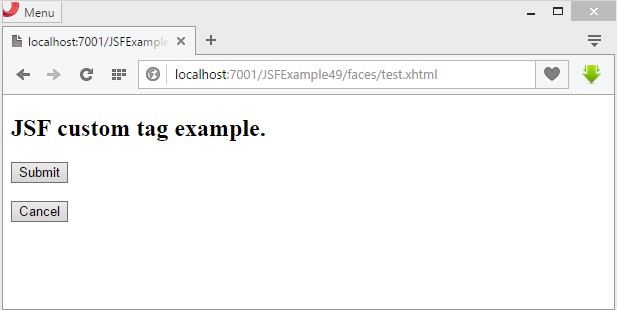JSF custom tag example:
JSF provides the facility to create custom tag to render a pre-defined content. A JSF custom tag uses “ui:composition” to insert content into the page.
Steps to create the JSF custom tag:
1. First create a predefined content in an XHTML page with ui:compisition tag.
2. Declares and define the custom tag details in a tag library descriptor.
3. Register the tag library descriptor in the web.xml file.
Example:
test.xhtml
<?xml version="1.0" encoding="UTF-8"?> <!DOCTYPE html PUBLIC "-//W3C//DTD XHTML 1.0 Transitional//EN" "http://www.w3.org/TR/xhtml1/DTD/xhtml1-transitional.dtd"> <html xmlns="http://www.w3.org/1999/xhtml" xmlns:h="http://java.sun.com/jsf/html" xmlns:f="http://java.sun.com/jsf/core" xmlns:ui="http://java.sun.com/jsf/facelets" xmlns:jwe="https://www.w3schools.blog/facelets"> <h:body> <h2>JSF custom tag example.</h2> <jwe:buttonPanel submitLabel="Submit" cancelLabel="Cancel" /> </h:body> </html> |
buttonPanel.xhtml
<?xml version="1.0" encoding="UTF-8"?> <!DOCTYPE html PUBLIC "-//W3C//DTD XHTML 1.0 Transitional//EN" "http://www.w3.org/TR/xhtml1/DTD/xhtml1-transitional.dtd"> <html xmlns="http://www.w3.org/1999/xhtml" xmlns:h="http://java.sun.com/jsf/html" xmlns:f="http://java.sun.com/jsf/core" xmlns:ui="http://java.sun.com/jsf/facelets"> <h:body> <ui:composition> <h:commandButton type="submit" value="#{submitLabel}" /> <br/><br/> <h:commandButton type="reset" value="#{cancelLabel}" /> </ui:composition> </h:body> </html> |
w3schools.taglib.xml
<?xml version="1.0" encoding="UTF-8"?> <!DOCTYPE facelet-taglib PUBLIC "-//Sun Microsystems, Inc.//DTD Facelet Taglib 1.0//EN" "http://java.sun.com/dtd/facelet-taglib_1_0.dtd"> <facelet-taglib> <namespace>https://www.w3schools.blog/facelets</namespace> <tag> <tag-name>buttonPanel</tag-name> <source>buttonPanel.xhtml</source> </tag> </facelet-taglib> |
faces-config.xml
<?xml version="1.0" encoding="windows-1252"?> <faces-config version="2.0" xmlns="http://java.sun.com/xml/ns/javaee" xmlns:xi="http://www.w3.org/2001/XInclude" xmlns:xsi="http://www.w3.org/2001/XMLSchema-instance" xsi:schemaLocation="http://java.sun.com/xml/ns/javaee http://java.sun.com/xml/ns/javaee/web-facesconfig_2_0.xsd"> </faces-config> |
web.xml
<?xml version="1.0" encoding="UTF-8"?> <web-app version="3.0" xmlns="http://java.sun.com/xml/ns/javaee" xmlns:xsi="http://www.w3.org/2001/XMLSchema-instance" xsi:schemaLocation="http://java.sun.com/xml/ns/javaee http://java.sun.com/xml/ns/javaee/web-app_3_0.xsd"> <servlet> <servlet-name>faces</servlet-name> <servlet-class> javax.faces.webapp.FacesServlet </servlet-class> </servlet> <context-param> <param-name> javax.faces.FACELETS_LIBRARIES </param-name> <param-value> /WEB-INF/w3schools.taglib.xml </param-value> </context-param> <servlet-mapping> <servlet-name>faces</servlet-name> <url-pattern>/faces/*</url-pattern> </servlet-mapping> </web-app> |
URL:
http://localhost:7001/JSFExample49/faces/test.xhtml
